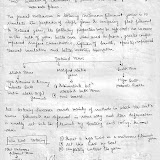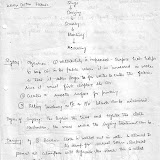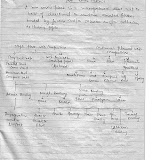Textile Notes related to fiber, yarn, fabric knowledge, spinning, weaving, processing, projects, knitting, Indian Traditional Textiles and denim manufacturing
Saturday, 12 January 2008
Wednesday, 9 January 2008
some interesting facts about textiles
- some of the linen fabrics found in Egyptian civilisation were so fine, that they had 216 warp threads per cm. while the finest linen woven in modern europe had only 140 warp threads/ cm
- It is reported that linen robes of Egyptian kings, nobles and priests were of such fine structures that it was possible to draw them through a small finger ring. They were often called 'woven air'
- The Pharaos of Egypt organised large spinning and weaving mills of Thebes, Penopolis, Memphis and other cities.
- Egyptian followers of christianity were called copts.Their outstanding contribution to the textile history is the art of tapestry weaving with directly coloured wood and undyed linen which they perfected.
- In egypt in (1304-1307), a fabric called Bukalemun, which changed its color with light was also made.
- Mesopotamia, is the birth place as well as the cradle of the wool
- Muslin name came from Mosul, a city in Persia
- Art of Carpet weaving is believed to be known as 3600 BC, oriented an original manuscript in which it is stated that ofter conquering Ketsiphon (651 AD), the capital of Persia, the Arbas found a huge carpet representing a garden. This was called Spring of Chosroes.
- In ancient Greece, weaving of woollen cloth was a house hold fashion. Later wool weaving becomes a separate occupation, carried by a class of citizens called textores from which the modern word textile came.
- The famous Halen of Troy kept herself busy with the work of directing the spinning and manufacturing of costly woven cloth for garments by the maidens of the household.
- The Word 'clew(clue)' came from a ball of woollen thread which as it was unwound was dropped on the ground by Theseus of Greece as he walked into the labyringth to kill the Minotous so that the thread would be a clue to guide him back to the entrance
- A loom was a household furniture in the ancient Greece
- The word 'cloth' is itself a Roman origin. Cloth was one of the three Fates, who wove human destiny, while Lachesis spun the thread of life, which was cut by Atropos, thus ending life.
- According to the edict of the Roman Senate of 16th AD, wearing of silk robes by men was prohibited in Rome
- Cambrai, an ancient cathedral town in North France, was prominent for the manufacture of smooth, thin, white linen, which took its name (Cambric) from the city where it was first woven.
- Joseph Marie Jacquard was born in Lyons (France) in 1752, as the son of a weaver with his mother as pattern maker, a knowledge of the loom was his great inheritance. He brought certain improvements in the loom and Napolean granted him an annuity provided he worked in Lyons and perfected his invention. He did not invent or change the loom but he invented an attachment which by a series of cards with punched holes to correspond with simple or elaborate patterns, controlled the raising and lowering of warp threads. This principle is used in the modern Jacquard looms.
- The word 'loom' came from the Anglo-Saxon word 'geloma' which means domestic utensil.
- Silk--> according to a legend a princess Si-Ling-Chi, the wife of a great prince Huang-ti, saw in a garden a small worm, wrapping itself in a beautiful cocoon. She took greater interest when she found that other worms doing the same thing. she took one of them in her hand, and discovered that with great care, she could unwind the cocoon and obtain a fine thread of great length. From then onwards she nurtured the worms and years later she could gather enough yarn to make a robe for her husband.
- In Japan during the Heian Period ( 795 to 1192) silk fabrics came to be valued as currency.
- In 1542, Indigo became so popular that there was at least one indigo dyer in every village or town in Japan
- Tie-and -Die work originated in Indonesia
- Royal Purple or Tyrian Purple ( obtained from a small shell fish which was abundan in the water near Tyre), the royal color of the Roman Empire ( first few centuries of the Christian era) was so costly that the Roman Emperor Diocleian in 301 A.D. fixed the price of wool dyed with this dye at an equivalent of Rs. 3000 per pound in Gold. ( of course 1200 shell fish gave about 1 gm of the dye !!)
Subscribe to:
Posts (Atom)



